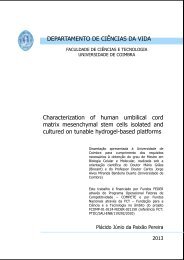role of th1 and th17 cd4+ t cell subsets in the pathogenesis of ...
role of th1 and th17 cd4+ t cell subsets in the pathogenesis of ...
role of th1 and th17 cd4+ t cell subsets in the pathogenesis of ...
Create successful ePaper yourself
Turn your PDF publications into a flip-book with our unique Google optimized e-Paper software.
Figure 1.3 ‐ Important events <strong>in</strong> <strong>the</strong> history <strong>of</strong> <strong>the</strong> IL‐17 <strong>and</strong> TH17 <strong>cell</strong> field [adapted from<br />
(Gaffen, 2009)]<br />
The discovery <strong>of</strong> Foxp3 + iTregs <strong>and</strong> Th17 <strong>cell</strong>s <strong>and</strong> <strong>the</strong>ir close relationship, as well as <strong>the</strong><br />
identification <strong>of</strong> molecules that affect more than one T <strong>cell</strong> subset, described above, has<br />
shown that <strong>the</strong>se <strong>subsets</strong> have more <strong>in</strong> common than dist<strong>in</strong>ctions <strong>and</strong>, <strong>the</strong>refore, have<br />
revised researcher’s concepts <strong>of</strong> CD4 + T helper <strong>cell</strong> commitment to a specific phenotype<br />
as an endpo<strong>in</strong>t. The concept <strong>of</strong> plasticity <strong>in</strong> T helper <strong>cell</strong>s was based on <strong>the</strong> observation<br />
that T <strong>cell</strong>s show great flexibility <strong>in</strong> <strong>the</strong>ir differentiation options both <strong>in</strong> vivo <strong>and</strong> <strong>in</strong> vitro<br />
depend<strong>in</strong>g on <strong>the</strong> milieu. For example, IL‐17 <strong>and</strong> IFNγ double positive population was<br />
identified with<strong>in</strong> CD4 + CNS‐<strong>in</strong>filtrat<strong>in</strong>g MOG peptide 35‐55 specific T <strong>cell</strong>s <strong>in</strong> <strong>the</strong> CNS <strong>of</strong><br />
actively <strong>in</strong>duced EAE sick mice (Suryani <strong>and</strong> Sutton, 2007). In <strong>the</strong> context <strong>of</strong> Th17 <strong>and</strong><br />
Foxp3 + iTregs <strong>cell</strong>s, TGFβ can orchestrate both T <strong>cell</strong> differentiation programs <strong>in</strong> a<br />
concentration‐dependent manner (Zhou et al., 2008). Also, all‐trans ret<strong>in</strong>oic acid (ATRA)<br />
<strong>in</strong>duces Foxp3 + <strong>cell</strong>s <strong>and</strong> decreases <strong>the</strong> frequency <strong>of</strong> Th17 <strong>cell</strong>s, mediated by <strong>the</strong> nuclear<br />
ret<strong>in</strong>oic acid receptor‐alpha (RARα) (Schambach et al., 2007). F<strong>in</strong>ally, <strong>the</strong>re are Th1 <strong>cell</strong>s<br />
which produce simultaneously with IFNγ <strong>the</strong> anti‐<strong>in</strong>flammatory cytok<strong>in</strong>e IL‐10 <strong>in</strong> certa<strong>in</strong><br />
conditions such as <strong>in</strong>fections <strong>in</strong> order to regulate <strong>the</strong>ir <strong>in</strong>flammatory reactions <strong>and</strong><br />
m<strong>in</strong>imize immunopathology (O'Garra <strong>and</strong> Vieira, 2007).<br />
34

















